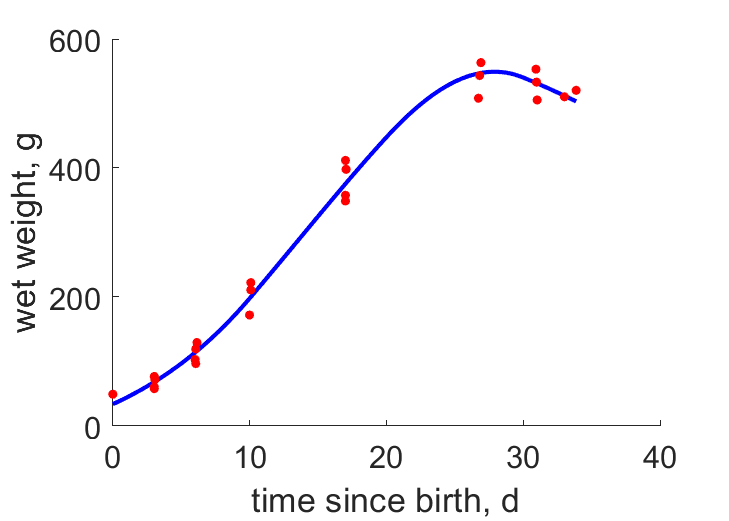Predictions & Data for this entry
| Model: std | climate: BW, BSk | migrate: Ms | phylum: |
| COMPLETE = 2.5 | ecozone: TA | food: biCi, biCv | class: |
| MRE = 0.031 | habitat: 0iTh, 0iTg, 0iTa | gender: Dg | order: |
| SMSE = 0.003 | embryo: Tncf, Tnpf | reprod: O | family: |
Zero-variate data
| Data | Observed | Predicted | (RE) | Unit | Description | Reference |
|---|---|---|---|---|---|---|
| ab | 31 | 31.7 | (0.02244) | d | age at birth | AnAge |
| tx | 37 | 36.95 | (0.00135) | d | time since birth at fledging | avibase |
| tp | 111 | 109.3 | (0.01519) | d | time since birth at puberty | guess |
| tR | 547.5 | 547.5 | ( 0) | d | time since birth at 1st brood | avibase |
| am | 6278 | 6289 | (0.001753) | d | life span | AnAge |
| Ww0 | 49 | 43.57 | (0.1108) | g | initial wet weight | avibase |
| Wwb | 30.6 | 33.63 | (0.09905) | g | wet weight at birth | avibase |
| Wwi | 944 | 950.8 | (0.007179) | g | ultimate wet weight for female | avibase |
| Wwim | 565 | 563.2 | (0.003139) | g | ultimate wet weight for male | avibase |
| Ri | 0.01233 | 0.01224 | (0.007047) | #/d | maximum reprod rate | avibase |
Uni- and bivariate data
| Data | Figure | Independent variable | Dependent variable | (RE) | Reference |
|---|---|---|---|---|---|
| tW |  | time since birth | wet weight | (0.05308) | Fowl1931 |
Pseudo-data at Tref = 20°C
| Data | Generalised animal | Falco mexicanus | Unit | Description |
|---|---|---|---|---|
| v | 0.02 | 0.02456 | cm/d | energy conductance |
| p_M | 18 | 848 | J/d.cm^3 | vol-spec som maint |
| k_J | 0.002 | 0.03475 | 1/d | maturity maint rate coefficient |
| k | 0.3 | 0.3003 | - | maintenance ratio |
| kap | 0.8 | 0.963 | - | allocation fraction to soma |
| kap_G | 0.8 | 0.7993 | - | growth efficiency |
| kap_R | 0.95 | 0.95 | - | reproduction efficiency |
Discussion
- Males are assumed to differ from females by {p_Am} only
- Scaled functional response varies in time
- mod_1: Pseudo-data point k is used, rather than k_J; Data set tp and parameter t_R are added, the latter replacing clutch interval t_N. Postnatal T is based on PrinPres1991, see get_T_Aves. See further the revision page, theme puberty
Bibliography